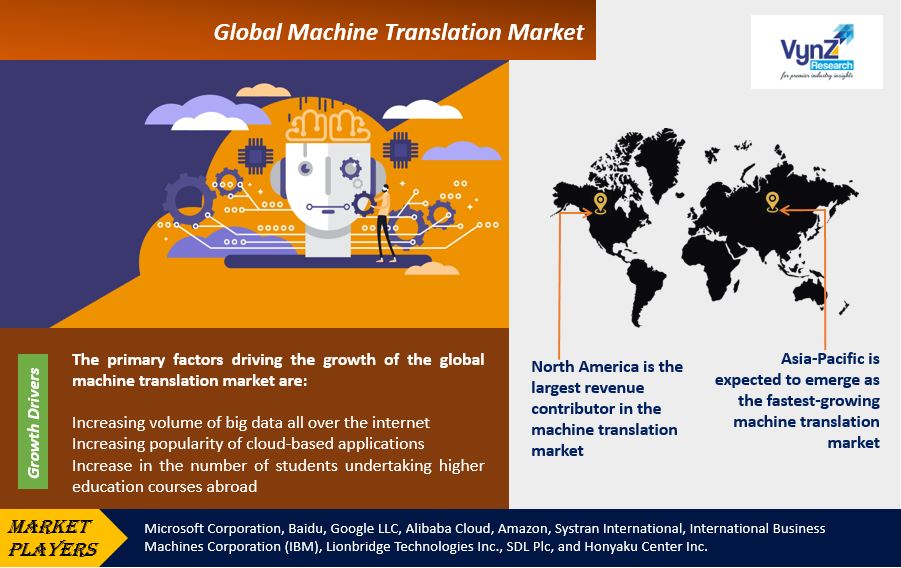Industry Overview
The global machine translation market was valued at USD 1.1 billion in 2023 and is predicted to reach USD 3.3 billion by 2030, growing at a CAGR of 7.8% during the forecast period.
Machine Translation technology offers more accurate translations relevant to the context. There are a diverse range of players in the industry and more and more startups and service providers are emerging, which influences the growth of this market. Its usefulness and features make it an indispensable tool for several organizations across a diverse range of industry verticals.
The growth factors of the global machine translation market include the usage of large volumes of big data over the Internet. It is also attributed to the growing demand for and use of cloud-based applications as well as the rise in the number of students going abroad for their higher studies.

Machine Translation Market Segmentation
Insight by Technology
According to the technology, the global machine translation market is divided into Statistical Machine Translation (SMT), Rule-Based Machine Translation (RBMT), and Neural Machine Translation (NMT) segments.
Out of these three categories, the SMT technology has a higher share and dominates the market due to the diverse set of benefits it offers such as higher customizability and also in terms of community collaboration and resource requirements. These benefits result in a wider acceptance of this technology.
Insight by Deployment Type
According to the deployment type, the global machine translation market is divided into on-premises and cloud. Out of these two categories, the on-premises machine translation market is expected to grow at a higher rate than the other during the forecast period. The most significant reason behind this growth is the rising demand for it in the corporate sectors to maintain confidentiality.
Insight by Application
According to the applications, the global machine translation market is divided into healthcare and life sciences, military & defense, travel & hospitality, legal & law firms, banking & finance, automotive, electronics, IT & telecom services, retail & manufacturing, media & entertainment, and others.
Out of these segments, the retail & manufacturing category is expected to grow at a faster rate than the others during the forecast period. This is mainly due to the growing demand for machine translation among retailers to increase their sales beyond borders, improve their influence, and use a go-to-market approach.
Global Machine Translation Market Report Coverage
|
Report Metric
|
Details
|
|
Historical Period
|
2018 - 2023
|
|
Base Year Considered
|
2024
|
|
Forecast Period
|
2025 - 2030
|
|
Market Size in 2024
|
U.S.D. 1.1 Billion
|
|
Revenue Forecast in 2030
|
U.S.D. 3.3 Billion
|
|
Growth Rate
|
7.8%
|
|
Segments Covered in the Report
|
By Technology, By Deployment Type, and By Application
|
|
Report Scope
|
Market Trends, Drivers, and Restraints; Revenue Estimation and Forecast; Segmentation Analysis; Impact of COVID-19; Companies’ Strategic Developments; Market Share Analysis of Key Players; Company Profiling
|
|
Regions Covered in the Report
|
North America, Europe, Asia-Pacific, Middle East, and Rest of the World
|
Industry Dynamics
Machine Translation Market Growth Drivers
The three major growth drivers of the global machine translation market are the higher use of big data, the growing popularity and usage of cloud-based applications, and a larger number of students pursuing their higher studies abroad.
Moreover, the growing demand for localization of websites, products, applications, and other content has also influenced the growth of the global machine translation market. This helps companies to communicate with their target audience more effectively using the local language. In addition, it also offers other significant benefits such as integrating industry-specific facets concerning the specific culture. This helps in creating a fantastic and more effective local appeal. Machine Translation Software also helps the global machine translation market to grow due to its efficiency. Its licensing and development automatically translate text or speech from one language to another by using different models and algorithms in the process. The growing need for customization and integration services among several organizations has also augmented the use of machine translation systems. They can tailor them according to their needs and even integrate them into the existing software or workflow.
Another significant contributor to the growth of the global machine translation market is the cloud-based machine translation services. These services are very efficient in providing translation on-demand and their translation solutions are quite scalable. These are also easily accessible via different Application Programming Interfaces (APIs) or Software-as-a-Service (SaaS) models.
Machine Translation Market Challenges
The growth of the global machine translation market is somewhat hindered by the threats from free translation service providers. However, better services and technological developments will allow for mitigating such threats and push the global machine translation market northward.
Recent Developments By the Key Players
Microsoft Corp. expanded its Phi line of open-source language models with two new algorithms optimized for multimodal processing and hardware efficiency. The first addition is the text-only Phi-4-mini. The second new model, Phi-4-multimodal, is an upgraded version of Phi-4-mini that can also process visual and audio input.
AT&T joined hands with an agreement to create a standalone managed cybersecurity services business, and a capital investment in that business from WillJam Ventures which is a Chicago-based investor with deep cybersecurity industry and leadership experience. The new cybersecurity partnership shall select security software solutions, associated managed security operations and security consulting resources.
IT services provider NTT Data has launched its new managed detection and response (MDR) service for security management. The offering will be rolled out in Japan. With the new service, advanced security engineers will provide support to clients to manage a security function.
Machine Translation Market Geographic Overview
North America is the largest contributor to the global machine translation market in terms of revenue. This is mainly due to the rising need for such effective solutions in the military and defense sectors.
However, the Asia-Pacific region is also expected to grow at a significant rate during the forecast period due to the noteworthy growth of overseas businesses, an increase in the number of high-net-worth individuals (HNWIs), a large customer base, growing and higher income levels, and the existence of diverse languages in the region.
Machine Translation Market Competitive Insight
Key players operating in the global machine translation market include :
Primary Research
VynZ Research conducts extensive primary research to understand the market dynamics, validate market data and have key opinions from the industry experts. The key profiles approached within the industry includes, CEO, CFO, CTO, President, Vice President, Product Managers, Regional Heads and Others. Also, end user surveys comprising of consumers are also conducted to understand consumer behavior.
The Machine Translation Market report offers a comprehensive market segmentation analysis along with an estimation for the forecast period 2025–2030.
Segments Covered in the Report
- By Technology
- Statistical Machine Translation (SMT)
- Rule-based Machine Translation (RBMT)
- Neural Machine Translation (NMT)
- Others
- By Deployment Type
- By Application
- Military & Defence
- Healthcare & Lifesciences
- Automotive
- Travel & Hospitality
- Legal & Law Firms
- Banking & Finance
- Electronics
- IT & Telecom Services
- Retail & Manufacturing
- Media & Entertainment
- Others
Region Covered in the Report
- North America
- Europe
- Germany
- U.K.
- France
- Italy
- Spain
- Russia
- Rest of Europe
- Asia-Pacific (APAC)
- China
- Japan
- India
- South Korea
- Rest of Asia-Pacific
- Rest of the World (RoW)
- Brazil
- Saudi Arabia
- South Africa
- U.A.E.
- Other Countries
.png)
Source: VynZ Research
.png)
Source: VynZ Research



.png)
.png)